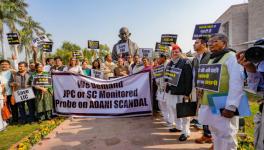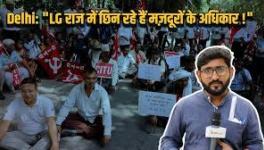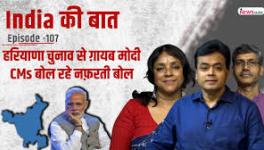Who After Modi?
Image for representational use only; Image Courtesy : Jansatta
Politics is about possibilities and analysing politics involves pre-empting and decoding them. One such relevant question is, if Bharatiya Janata Party (BJP) fails to get a majority in Parliament in 2019, will it witness a terminal decline of the party for a long-time to come in Indian politics?
Narendra Modi, even as he raised the bogey of dynasty rule, managed to displace the legitimacy of a second rung leadership in BJP. Most of the senior leaders in the party are either not mass leaders struggling to mobilise electoral dividends or are a spent force.
Sushma Swaraj has already declared her intention not to contest elections due to failing health, so is Arun Jaitley, who has both health issues and lost elections from Punjab. Manohar Parrikar, too, is sailing in the same boat. This leaves the BJP with a choice of projecting Nitin Gadkari, who is more a managerial face of the BJP than a charismatic leader. He might be a poor second choice of the Rashtriya Swayamsevak Sangh (RSS), but cannot be the symbol of brand-Hindutva to bring electoral success.
Other regional leaders, such as former Chief Ministers Shivraj Singh Chouhan from Madhya Pradesh and Raman Singh from Chhattisgarh, in spite of similar success as Modi, failed to emerge as national leaders and were not inducted for campaigning in other parts of India. Somehow, the current leadership of the BJP did not create the space necessary for both these leaders. In none of the Assembly election campaign speeches did Modi project the achievements of either of them, instead in Chhattisgarh, he projected a false narrative of `urban Naxals` and in Madhya Pradesh he focused on critiquing the Congress. This could well be one of the reasons for the close loss in both the states.
This leaves out Uttar Pradesh Chief Minister Yogi Adityanath as the only other face left for BJP with some credence as a national leader. Adityanath has, however, managed to misgovern the state in a very short period of time. His `encounter` policy followed by his nonchalant response to the death of police officer Subodh Kumar Singh in the Bulandshahr mob violence, and preceded by his insensitive response to the death of children in aGorakhpur hospital, has made it difficult to project him as an able administrator.
Adding insult to injury, Yogi Adityanath, during his Jana Raksha Yatra campaign in Kerala in 2017, asked the Kerala government to learn about managing public health from the UP government. His more recent statements on Hanuman being a dalit have already put him in the dock in mobilising the underprivileged castes, unlike Modi. A series of attacks on dalits by Thakurs has given him a clear image of favouring the dominant castes.
Yogi would have stood the chance of emerging as a national leader had he continued to project himself as representing agrarian interests, against the growing corporatisation of the economy. He began well with a promise of a massive loan waiver but even that turned out to be hoax with many of the beneficiaries receiving bizarre amounts of Rs 2 as a loan waiver.
The projected balance between development and Hindutva that was the corner- stone of the new age discourse of BJP-RSS combine is missing in the image Yogi has projected. Instead, he has come to represent a hyperbole of empty rhetoric in most of his campaign speeches. In Telangana, for instance, where the elections were clearly being fought on a welfare agenda, the UP Chief Minister focused exclusively on attacking Asaddudin Owaisi, the All India Majlis-e-Ittehad-ul Muslimeen leader, and on the renaming of Hyderabad. Both were non-issues for the majority of the electorate, and his party got reduced to winning just one seat in the recent Assembly elections.
Not only did Yogi Adityanath lose the by- elections in his own constituency in Uttar Pradesh, but his party also lost elections in most of the constituencies he campaigned for. A hyperbolic campaign can work in certain moments of anxiety but as a sustained electoral discourse allows the electorate to see through the futility of violent imageries. It could work in a place like Uttar Pradesh but to believe that the same kind of rhetoric would work in rest of India foregrounds the narrow-political narrative of ‘Brand-Yogi’.
In case of loss of power for BJP in 2019, it will witness a strange situation of achieving a certain kind of social hegemony for the Hindutva discourse with a political failure to translate it into electoral dividends. While the grassroots activism of RSS can build a social narrative, it cannot automatically translate itself into a viable political narrative. Politics and elections are often besieged by more pressing issues of development, rural poverty, unemployment, among many other such issues. The social agenda of Hindutva can translate into a viable electoral success only when combined with other developmental issues.
The rise of Narendra Modi had also witnessed many other dimensions, including raising the aspirations, making-large scale promises, such as creation of two crore jobs, Make-in-India project, cooperative federalism, Start-up India, talk about youth and demographic dividends, among others. On most of the issues, the current regime failed to deliver. This fiat of sailing through by making promises cannot be repeated the second time. Given the declining credibility of the ability of BJP to deliver on electoral promises made, the second time around it will face a more strident evaluation and scrutiny by the electorate. In such a situation, for the BJP to grow under the leadership of Yogi Adityanath, looks to be an uphill task.
Finally, the Modi brand of politics brought in a unique feature of not just a personality cult that projects a larger-than-life media image but it has, perhaps, for the first time involved the personal nature, and a close evaluation of who the human-person is behind the power-grids. The systematic undermining of the institutions, while allowing unprecedented centralisation of power, also bares the individuals who otherwise are evaluated and mediated through institutional functioning. It was perhaps for the first time that there was a personal evaluation of who Narendra Modi was as an individual, when DMK leader M.K.Stalin commented that Modi was not only a fascist but also a `sadist`.
As democracies allow for dysfunctional institutions, they find other ways of making the public representatives accountable. The emergent leadership of the BJP will now have to pass through this prism of who the corporeal entity is behind the political discourses, and here too it will continue to face stiff evaluation. It will remain a possibility that under these evaluative conditions, BJP will face an uphill task and might end-up benefitting other parties with more accommodative, compassionate, and responsible leadership.
It is the irony of democracy how the failures of Congress on the one hand, and the discourse of development initiated by them lead to an aspirational mood, on the other, benefiting the rise of Modi. In a similar fashion, the new trends introduced by the BJP/RSS combine in the last few years, might pave the way for other political parties to reap the benefits.
The writer is Associate Professor, Centre for Political Studies, Jawaharlal Nehru University, Delhi. The views are personal.
Get the latest reports & analysis with people's perspective on Protests, movements & deep analytical videos, discussions of the current affairs in your Telegram app. Subscribe to NewsClick's Telegram channel & get Real-Time updates on stories, as they get published on our website.
























